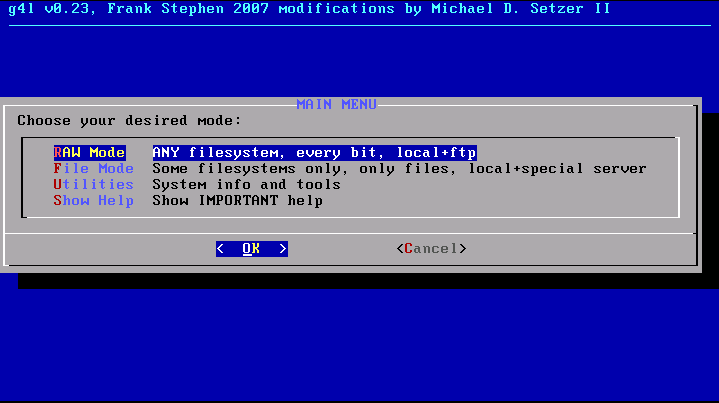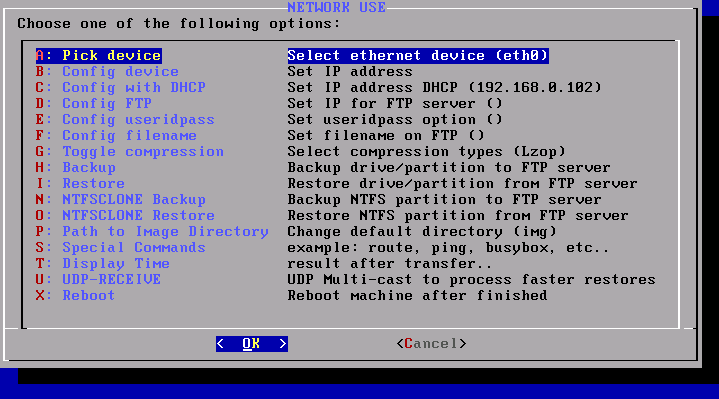Whether you're backing up, deploying multiple Linux and Windows desktops, or cloning your installation to a larger drive, Ghost for Linux (G4L) can be very helpful.
One can never have too many backups, trust me. Whether you want to create full disk and partition backups or you want to clone drives for deployment purposes, many commercial programs are available to help you. Chances are you've used Norton's Ghost utility to create full-disk image backups, partition backups, or file-based snapshots of your hard drives. There is an alternative, however, and Ghost for Linux (G4L) is a slightly trimmed-down open-source equivalent of Norton's product that's maintained by Michael Setzer.
Uses and Supported Interfaces
You can obtain the latest version of G4L at Sourceforge. The download is an ISO image that you burn to CD and boot up on the host you want to image or back up. The small distribution is running a Linux kernel with support for PATA, SATA, and SCSI drives. Once booted up, a nice ncurses GUI makes it easy to input options. G4L supports cloning and copying images directly to other disks or to any FTP server that you have set up to allow read and write permissions. The FTP options make it perfect for backups, while the Click 'n' Clone option is great for duplicating hard-drive setups.
Click 'n' Clone
If you simply want to clone a hard drive to another drive, install the second drive. Typically, you should use identically sized drives (you can get away with using larger drives, but not smaller drives). Click 'n' Clone is perfect for doing an installation on one hard drive and then cloning it for multiple deployments with any operating system. Once you have your hardware ready to go, boot up G4L.
The first page displayed is the disclaimer and author information. The second page is the options that you can pass to G4L at the command line, but we won't be using the command line. Instead, we'll use the ncurses GUI. Go ahead and Exit twice to get the command line, and then type the following to start the ncurses GUI.
-bash-3.2# g4l
After you agree to the terms of use, you will see a screen like the following figure.

Figure 1: This is G4L's main menu.
Select the RAW Mode option to go to the next menu and then choose the Click 'n' Clone option. From here, you can select the source and target drives to clone. If you have two IDE PATA drives, you should typically see the first drive as hda and the second drive as hdb (or something similar). To do a bit-by-bit clone, simply choose hda as the source drive and hdb as the target. To toggle choices within the menu for selecting drives and partitions, use the spacebar to mark the items. To start the process, highlight Click 'n' Clone and hit Enter.
Imaging Across FTP
Being able to create and restore images across an FTP server is definitely more convenient than installing multiple hard drives to do the job. All that's required is a working FTP server with both read and write permissions. There are plenty of resources available online for setting up both Windows and Linux FTP servers. Once you have a working FTP server up and running, enter the RAW Mode menu and then the Network Use menu under G4L. The network menu looks like the image below.

Figure 2: And this is G4L's FTP networking menu.
Configure your FTP server's IP address in option D, and then configure the appropriate user and password credentials in option E. Within option F, ensure your image has a specific name. An example might be hda_machinename.img as the image name. Option G contains three choices for compression: Gzip, Lzop, and Bzip2. Choose the option best for yourself. Remember that compression will require much more CPU power to complete the process.
If you're doing a backup, set the drive or partition you want to image with option H. To restore an image to a partition or drive, use option I to select where to restore to. Using the NTFSCLONE backup and restore options, you can run G4L across Windows NTFS partitions. Once you have all your options set up correctly, choose OK to continue.
Utilities
G4L also comes with a few useful utilities that might come in handy. In the Utilities menu, you'll find system information, which displays information about the drives and partitions connected to the system. And the dd_rescue tool attempts to rescue a failed file system and clone it to a new drive. This can be particularly useful if you have a dying drive or a partition that has some file system errors and problems. Lastly, you can launch the parted tool. Parted allows you to create, destroy, resize, and check on partitions and file systems.
Many Uses
As demonstrated, G4L has many uses specific to drives and partitions. While it isn't as full-featured as Norton Ghost, it's extremely useful for backing up partitions and cloning drives. Whether you're backing up, deploying multiple Linux and Windows desktops, or running out of room on a drive and need to clone your installation to a larger drive, you should find Ghost for Linux very helpful for your daily IT tasks.












 Business users want new applications now. Market and regulatory pressures require faster application updates and delivery into production. Your IBM i developers may be approaching retirement, and you see no sure way to fill their positions with experienced developers. In addition, you may be caught between maintaining your existing applications and the uncertainty of moving to something new.
Business users want new applications now. Market and regulatory pressures require faster application updates and delivery into production. Your IBM i developers may be approaching retirement, and you see no sure way to fill their positions with experienced developers. In addition, you may be caught between maintaining your existing applications and the uncertainty of moving to something new. IT managers hoping to find new IBM i talent are discovering that the pool of experienced RPG programmers and operators or administrators with intimate knowledge of the operating system and the applications that run on it is small. This begs the question: How will you manage the platform that supports such a big part of your business? This guide offers strategies and software suggestions to help you plan IT staffing and resources and smooth the transition after your AS/400 talent retires. Read on to learn:
IT managers hoping to find new IBM i talent are discovering that the pool of experienced RPG programmers and operators or administrators with intimate knowledge of the operating system and the applications that run on it is small. This begs the question: How will you manage the platform that supports such a big part of your business? This guide offers strategies and software suggestions to help you plan IT staffing and resources and smooth the transition after your AS/400 talent retires. Read on to learn:
LATEST COMMENTS
MC Press Online